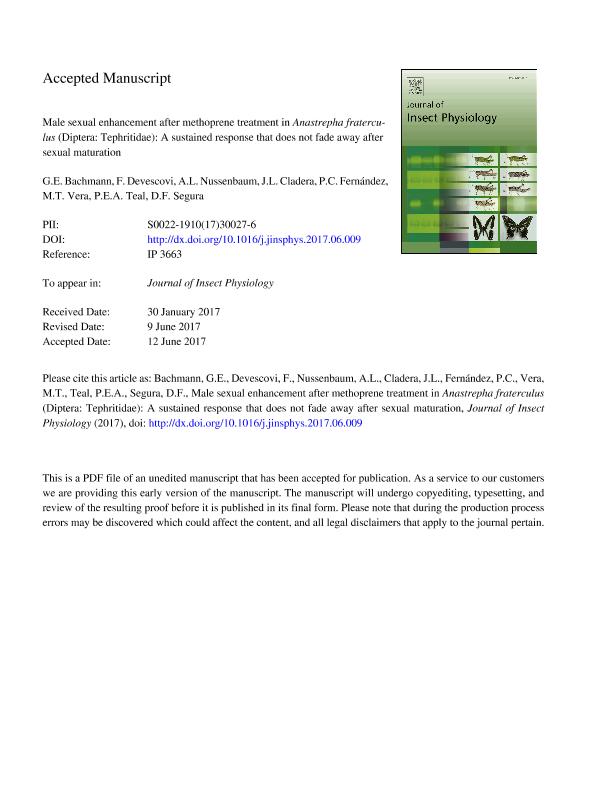Mostrar el registro sencillo del ítem
dc.contributor.author
Bachmann, Guillermo Enrique

dc.contributor.author
Devescovi, Francisco

dc.contributor.author
Nussenbaum, Ana Laura

dc.contributor.author
Cladera, Jorge Luis

dc.contributor.author
Fernandez, Patricia Carina

dc.contributor.author
Vera, María Teresa

dc.contributor.author
Teal, P. E. A.
dc.contributor.author
Segura, Diego Fernando

dc.date.available
2019-03-21T15:56:23Z
dc.date.issued
2017-08
dc.identifier.citation
Bachmann, Guillermo Enrique; Devescovi, Francisco; Nussenbaum, Ana Laura; Cladera, Jorge Luis; Fernandez, Patricia Carina; et al.; Male sexual enhancement after methoprene treatment in Anastrepha fraterculus (Diptera: Tephritidae): A sustained response that does not fade away after sexual maturation; Pergamon-Elsevier Science Ltd; Journal of Insect Physiology; 101; 8-2017; 7-14
dc.identifier.issn
0022-1910
dc.identifier.uri
http://hdl.handle.net/11336/72192
dc.description.abstract
The juvenile hormone (JH) of insects triggers physiological changes related to reproduction in adults of both sexes. Methoprene is a sesquiterpene with some effects that are analogous to those of JH. Treatments with methoprene accelerate sexual maturation in males of the South American fruit fly Anastrepha fraterculus, giving young males a mating advantage over non-treated males of the same age. Here, we evaluated the effects of methoprene treatment on A. fraterculus males after the sexual maturation phase and tested whether this compound provides a long-term mating advantage. Moreover, we took the first step to unravel the mechanisms that underlie male sexual enhancement. We treated males 1 day or 8 days after adult emergence and compared mate choice between recently matured (young) females and females that had been mature for ca. 10 days (aged females). We also addressed methoprene treatment effects on male sexual signalling. We found that methoprene treatment enhanced male sexual competitiveness even after the sexual maturation phase, and the effect did not decrease until males were older than 20 days. However, when methoprene treatment was carried out close to sexual maturity, the mating enhancement was no longer observed, suggesting a non-immediate effect and excluding the possibility that methoprene acts as a pheromonal compound. Young and aged females tended to mate more frequently with treated-males. This might indicate that in a context of sexual selection, the potential benefits associated with reproductive success would be similar for females of both ages. Treated males released larger amounts of pheromonal compounds than non-treated males, but their courtship behaviour was not altered to the same extent, suggesting that methoprene treatment may accelerate differently the components of male courtship. We discuss potential benefits of using methoprene to increase the efficiency of the sterile insect technique, which is an environmentally safe method to control this important South American fruit pest.
dc.format
application/pdf
dc.language.iso
eng
dc.publisher
Pergamon-Elsevier Science Ltd

dc.rights
info:eu-repo/semantics/openAccess
dc.rights.uri
https://creativecommons.org/licenses/by-nc-nd/2.5/ar/
dc.subject
Juvenile Hormone Analogue
dc.subject
Mating Success
dc.subject
Sesquiterpene
dc.subject
Sit
dc.subject
South American Fruit Fly
dc.subject
Sterile Insect Technique
dc.subject.classification
Otras Ciencias Biológicas

dc.subject.classification
Ciencias Biológicas

dc.subject.classification
CIENCIAS NATURALES Y EXACTAS

dc.title
Male sexual enhancement after methoprene treatment in Anastrepha fraterculus (Diptera: Tephritidae): A sustained response that does not fade away after sexual maturation
dc.type
info:eu-repo/semantics/article
dc.type
info:ar-repo/semantics/artículo
dc.type
info:eu-repo/semantics/publishedVersion
dc.date.updated
2019-03-21T14:20:16Z
dc.journal.volume
101
dc.journal.pagination
7-14
dc.journal.pais
Estados Unidos

dc.description.fil
Fil: Bachmann, Guillermo Enrique. Consejo Nacional de Investigaciones Científicas y Técnicas; Argentina. Instituto Nacional de Tecnología Agropecuaria. Centro de Investigación en Ciencias Veterinarias y Agronómicas. Instituto de Genética; Argentina
dc.description.fil
Fil: Devescovi, Francisco. Consejo Nacional de Investigaciones Científicas y Técnicas; Argentina. Instituto Nacional de Tecnología Agropecuaria. Centro de Investigación en Ciencias Veterinarias y Agronómicas. Instituto de Genética; Argentina
dc.description.fil
Fil: Nussenbaum, Ana Laura. Consejo Nacional de Investigaciones Científicas y Técnicas; Argentina. Instituto Nacional de Tecnología Agropecuaria. Centro de Investigación en Ciencias Veterinarias y Agronómicas. Instituto de Genética; Argentina
dc.description.fil
Fil: Cladera, Jorge Luis. Instituto Nacional de Tecnología Agropecuaria. Centro de Investigación en Ciencias Veterinarias y Agronómicas. Instituto de Genética; Argentina
dc.description.fil
Fil: Fernandez, Patricia Carina. Consejo Nacional de Investigaciones Científicas y Técnicas; Argentina. Instituto Nacional de Tecnología Agropecuaria. Centro Regional Buenos Aires Norte. Estación Experimental Agropecuaria Delta del Paraná; Argentina
dc.description.fil
Fil: Vera, María Teresa. Consejo Nacional de Investigaciones Científicas y Técnicas. Centro Científico Tecnológico Conicet - Tucumán; Argentina. Universidad Nacional de Tucumán. Facultad de Agronomía y Zootecnia; Argentina
dc.description.fil
Fil: Teal, P. E. A.. United States Department of Agriculture. Agricultural Research Service; Argentina
dc.description.fil
Fil: Segura, Diego Fernando. Consejo Nacional de Investigaciones Científicas y Técnicas; Argentina. Instituto Nacional de Tecnología Agropecuaria. Centro de Investigación en Ciencias Veterinarias y Agronómicas. Instituto de Genética; Argentina
dc.journal.title
Journal of Insect Physiology

dc.relation.alternativeid
info:eu-repo/semantics/altIdentifier/url/https://www.sciencedirect.com/science/article/pii/S0022191017300276
dc.relation.alternativeid
info:eu-repo/semantics/altIdentifier/doi/https://doi.org/10.1016/j.jinsphys.2017.06.009
Archivos asociados
